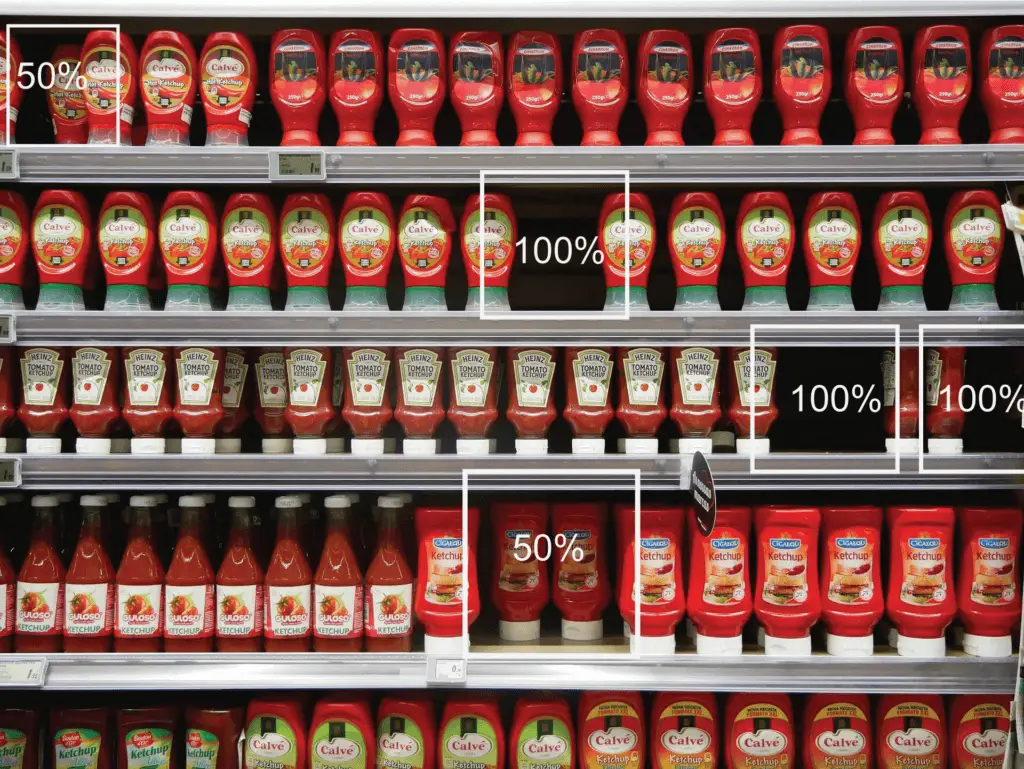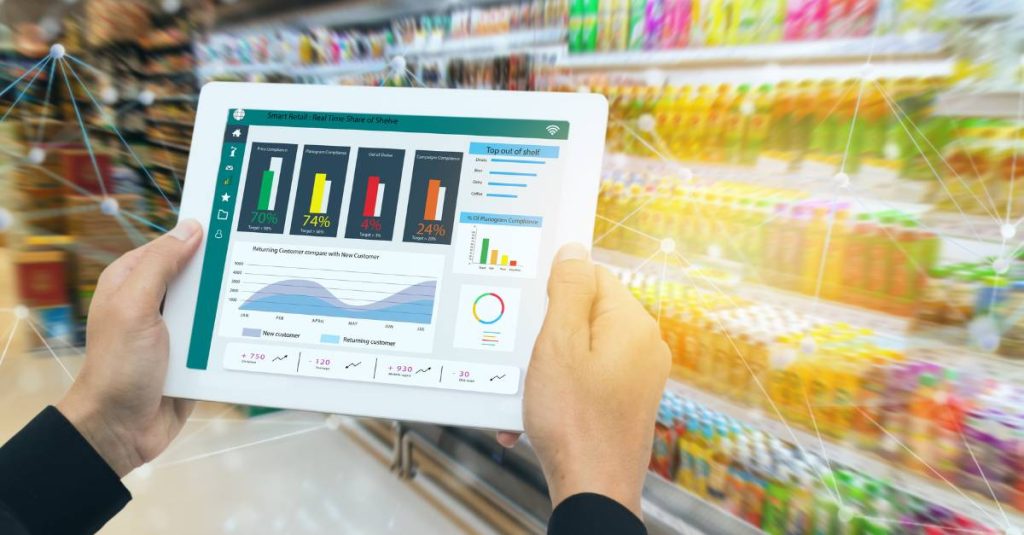When e-commerce is taking over the world, high street retailers are still searching for ways to up their data analytics efforts. AI retail shelf monitoring solutions provide retailers an opportunity to make smarter decisions about sales, marketing, staffing, security and many more.
AI shelf monitoring solutions deliver real-time, on-shelf information derived from in-store digital camera footage. Real time item availability information can significantly reduce out of stock rates.
Also, here are five ways AI shelf monitoring analytics can automate and optimize business performance.
Key Takeaway
AI-powered retail shelf monitoring solutions significantly improve retail business performance by providing real-time stock insights, preventing stockouts, optimizing resource allocation, and enhancing customer satisfaction, ultimately boosting efficiency and profitability.
Right here, Right Now: Solving the Stockout Conundrum
Communication gaps between store employees, scarce resources, overworked staff – all these factors can lead to out-of-stock circumstances.
Research indicates that 70-90% of stock-outs are caused by inefficient shelf restocking – meaning that the products are present in the store warehouse, but fail to make the ‘last mile’ onto the shelf.
Restocking forecasting often does not take into account peak customer traffic, weather patterns or other aspects that can disrupt customer flow trends.
It might be an efficient method to plan for store orders, but it doesn’t pass the litmus test when automated shelf restocking is needed.
Using in store security cameras AI shelf monitoring solutions monitor stock levels on a particular shelf and can notify employees when stock is running low.
The software further sends advance notifications to employees – while there are still some product items on the digital shelf – ensuring there’s ample time for restocking so that customers never encounter an empty shelf.

Effective Resource Allocation: Human Factors made into Business Processes
It narrows down to employee sense of ownership. If you have motivated accountable employees who cannot walk past an empty shelf – you are in luck! But shelf restocking efficiency even varies between employee shifts.
AI shelf monitoring solutions turn human based factors into business processes. The software sends real-time notifications to the shop assistant on duty when restocking is required. This also eliminates further blamestorming between staff of who was responsible to replenish the shelfs.
AI shelf monitoring solutions featuring computer vision also ease the life of retail managers. They can monitor product placement in real time. AI shelf analytics monitors planogram compliance and whether items on the shelf are laid out in the same fashion as they are ‘on paper’.

Hot or Cold: Measuring the Sales Temperature of Your Store Outlet
Besides monitoring stock levels, AI retail analytics can also evaluate the ‘sales temperature’ of the store layout. Is this stand based in a cold area often shunned by visitors? Which is the hottest place for my in-store marketing adverts? Was the placement of shelf-stoppers optimal?
By analyzing customer footfall in the store from security camera footage, AI retail analytics can identify cold and hot spots, as well as provide analytics on marketing efficiency – how many customers did stop for a particular sign; or insights about their shelf browsing behavior.
Such insights can be used for data-driven product planograms or insightful in-store marketing.
Increased Customer Satisfaction: Out of Stock, Out of Luck
According to research, 21% to 43% of consumers are more likely to visit a competitor store if they regularly find their favorite products out of stock. Grocery store visitors are not something people like to think about. It should provide as little friction as possible.
Failure to attend to basic customer needs leads into dissatisfaction and – perhaps – a permanent breakup.
Firstly retail AI analytics can help to ensure that products are easy to find and logically laid out. Secondly – reducing stockout situations – will reduce the likelihood of competitor store visits.

Make my Logo Bigger: Efficient Brand Visibility
AI retail analytics provide near real time insights. No visitor polling, no online surveys, no lengthy data analysis or human biases. Everything is presented in a clear cut, Google Analytics style dashboard.
Based on visitor flow data store managers can adapt planograms to particular store layouts. Real time metrics also assist merchandisers in their audit routine.
By taking a shelf picture with a dedicated merchant app, the software automatically checks planogram compliance and extracts price information from price labels, reducing the amount of man-hours required and reducing the risk of human errors in data processing.
Retail Shelf Monitoring FAQ
What is retail shelf monitoring solution?
A retail shelf monitoring solution is a technology that uses image recognition and AI-powered algorithms to provide real-time data and analytics on shelf inventory, on-shelf availability, and out-of-stock situations in retail stores.
It helps retailers optimize shelf management, automate stock management, and improve the shopping experience for shoppers.
How can a retailer optimize retail store operations with real-time analytics from shelf management solutions?
Implementing shelf management solutions like AI-powered shelf monitoring software delivers real-time analytics.
These analytics generate actionable insights based on data collected from SKUs, barcode readings, and image recognition.
How does AI-powered shelf monitoring automate out-of-stock alerts?
The AI-powered shelf monitoring solutions are equipped with image processing capabilities. These capabilities enable the system to identify stock gaps or out-of-stock scenarios in real time.
Once a gap is detected, an automated alert is sent to the management or inventory management system to replenish the stock, thereby automating out-of-stock situations and ensuring smooth store-level operations.
Can real-time analytics of the digital shelf contribute to ROI?
Absolutely. Real-time analytics provide a comprehensive view of the on-shelf inventory and its performance.
These insights make it possible for businesses to optimize their operations, reduce stockouts, and improve supply chain efficiency, consequently lowering operational costs and enhancing their ROI.
How are AI-driven systems automating the retail store’s inventory management?
AI-driven systems like shelf-monitoring software, allow automated inventory tracking by continually assessing on-shelf inventory.
They can amalgamate data from different sources like CCTV cameras, mobile apps, and barcode readings to provide an accurate picture of inventory levels.
This automated inventory management enhances efficiency and prevents overstocking or understocking scenarios.
Can shelf management solutions provide predictive analytics to help optimize retail businesses?
Yes. Shelf management solutions often come with predictive analytics capabilities. They can generate data and insights on historical sales patterns, customer behavior, and more.
By consolidating and analyzing this information, predictive analytics can help retailers make informed future business decisions, while optimizing retail operations and enhancing overall business performance.
What are the benefits of integrating automatic inventory management systems into retailer’s operations?
Automatic inventory management systems allow retailers to optimize retail store operations by providing real-time insights into stock levels, automating restocking alerts, and reducing store-level stockouts.
It also helps in preventing overstocking and understocking scenarios. By reducing operational costs and enhancing store efficiency, these systems can improve a retailer’s ROI.
How can retailers leverage smart shelves for optimizing store operations?
Smart shelves, powered by image recognition technology and shelf monitoring software, provide retailers with real-time insights into their shelf inventory.
They help optimize store operations by automating stock management, generating immediate restocking alerts, and ensuring price tag accuracy. This real-time shelf-monitoring aids in making effective business decisions.
What impact do AI-powered inventory management systems have on brick and mortar stores?
AI-powered inventory management systems can significantly enhance in-store operations in brick-and-mortar stores.
By providing real-time analytics and actionable insights, these systems help improve stock management, optimize supply chains, reduce operational costs, and increase customer satisfaction.
This ultimately contributes to boosting store performance and increasing ROI.
Conclusion
In conclusion, with the dynamic retail landscape continuously evolving, the adoption of AI-powered retail shelf monitoring solutions is no longer just an option, but a necessity for businesses aiming to thrive.
Our solution, designed to meet these modern retail challenges, offers an efficient and effective way to optimize your inventory management, enhance customer satisfaction, and boost overall store performance.
At EasyFlow, we specialize in providing these cutting-edge AI solutions, tailored to fit the unique needs of your retail business. We are here to help you navigate the complexities of inventory management with our innovative technology.
Discover how our AI retail shelf monitoring solution can transform your business. Visit easyflow.tech/shelf-performance-analytics for more information and to see how our expertise can benefit your retail operations.
Don’t hesitate to contact us – let us assist you in taking your retail business to new heights of efficiency and success.
Not Sure How AI Can Help Your Business? Let’s Talk!

Lukas Vaznelis
Business Development Manager
Book a no-obligation free consultation with our expert.


